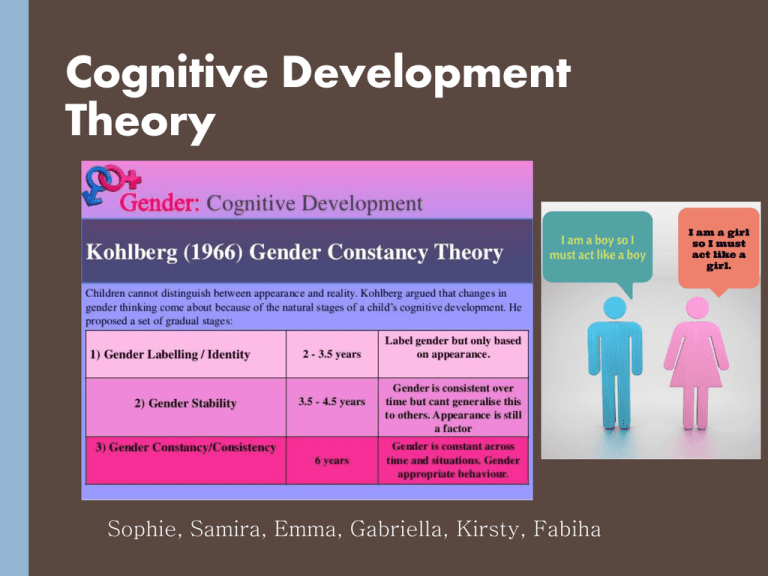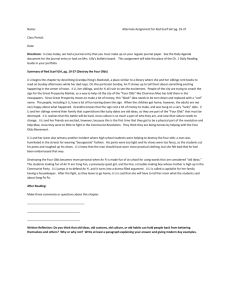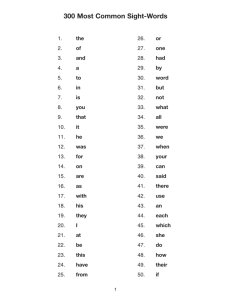Gender Schema Theory
advertisement

Cognitive Development Theory Sophie, Samira, Emma, Gabriella, Kirsty, Fabiha The Theory Kohlberg’s stages of gender development • Children understand the concepts of male and female in three stages, the children have to develop the concepts in a set order: • 1) Gender Identity (2-3): Child recognises that they’re male or female, but the knowledge is fragile. They don’t understand that boys grow into men and vice versa. • 2) Gender Stability(3-7): The child realises people retain their gender over a lifetime, but rely on superficial signs to determine Gender, e.g. Hair length • 3) Gender Consistency (7-12): Child realises Gender is permanent, even if someone doesn’t conform to the stereotypical physical appearance (e.g. men with long hair). When they achieve Gender Consistency they value the behaviours and attitudes associated with their gender, and identify with adults who possess them. • The theory says that children's thinking about gender determines when and how they show gender role behaviour (due to their cognition). • Once children acquire Gender Consistency they collect information about their gender role. For example, imitating role models of the same sex and following gender appropriate activities. • This is called self-socialisation as it doesn’t depend on other people such as parents, but what the child thinks themselves. Research Evidence • Martin and Little (1990) The 3-5 year olds studied had very little understanding of gender and yet still had strong gender stereotypes. They understood gender appropriate behaviour/ what girls and boys were “supposed” to do. This demonstrated that only basic gender understanding is needed to affect a child’s gender behaviour. • Slaby and Frey’s (1975) Children were tested to determine if they had achieved gender identity by being asked if they are a boy or a girl. They were shown a picture of a boy/girl and were told to choose which one they were. Gender stability involved questioning them on if they have and will always be a boy/girl. 3 year olds didn't understand any of the concepts, 4 year olds understood gender identity and by 5 years old, children understood all three concepts. The study found that children do go through the three stages Kolberg set. Quiz 1. What are the three stages to Kohlberg’s theory of gender development? 2. What does the child recognise in the first stage of gender development? 3. Fill in the gaps for this sentence related to the first stage of gender development: The child may _______ realise that little boys grow into ______, and that little _________ grow up into women. 4. Give an example of a superficial sign that children rely on in the second stage of their gender development, which they use to determine gender. 5. What do children realise in the last stage of their gender development, even if the person’s physical appearance changes? 6. Who do children identify with in the last stage of their gender development? 7. How old are children in the last stage of their gender development? 8. Fill in the gaps for this sentence related to gender development: The theory says that children are _____________ ______________ in their own gender role _____________________ - this means that they’re thinking that their gender _______________ when and how they show gender ________ behaviour. 9. What is it called when children have completed the three stages of gender development, and so they collect information about their gender role, imitate same sex models and follow gender appropriate activities? 10. What age group did Martin and Little study? 11. What did Martin and Little find? 12. How did Slaby and Frey carry out their study? 13. What were the results of Slaby and Fry’s study 14. What did Slaby and Fry find out about 3, 4 and 5 years old? Quiz answers 1. Gender identity Gender stability Gender consistency 2. That they are male or female 3. The child may not realise that little boys grow into men, and that little girls grow up into women 4. Hair length 5. That gender is permanent 6. Adults who possess the behaviours and attitudes associated with their gender 7. 7-12 years old 8. The theory says that children are active agents in their own gender role socialisation- this means that they’re thinking that gender determines when and how they show gender role behaviour 9. Self-socialisation 10. 3-5 years old 11. They found that they had very basic understanding of gender yet they had strong gender stereotypes about what girls and boys were supposed to do and had basic gender understanding is needed to affect the child’s gender behaviour. 12. They carried out a study by observing and questioning children by showing a picture of a girl and a boy and asking “which one are you?” (measures gender identity) and asking “when you grow up will you be a mummy or a daddy?” to measure consistency. 13. they found that children do go though the three staged in the set order that Kohlberg said. 14. 3 years olds didn’t understand any of the concepts. 4 years olds understood gender identity. By 5 children understood all three concepts.



